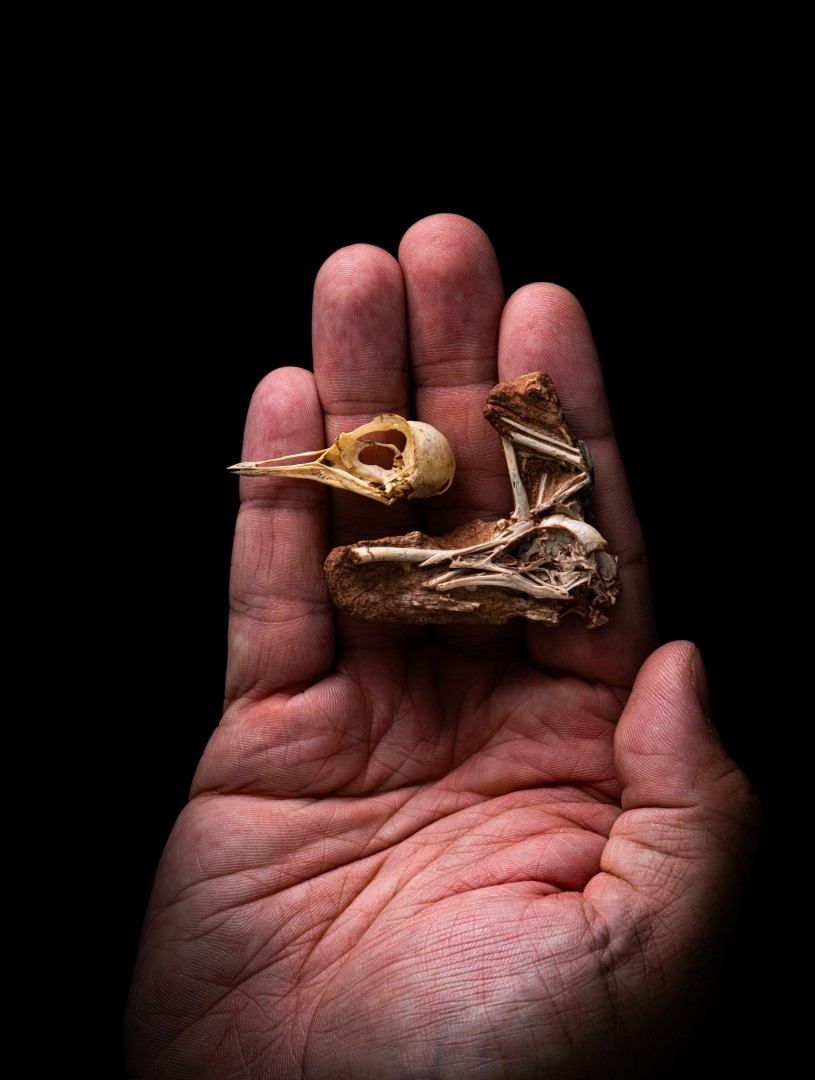Los Angeles, CA (November 13, 2024)—Fossil skulls are fundamental to understanding extinct animals’ stories, revealing key information about how they lived, like diet and brain characteristics. For birds, the same geological processes that preserve them have flattened the vast majority of fossilized skulls, shrouding key aspects of their evolution in near-total mystery. Now, the best-preserved bird skull yet discovered, belonging to the new species Navaornis hestiae, has opened a new chapter in the evolutionary saga of avian brains and skulls from the Age of Dinosaurs.
The new species reveals a tantalizing new chapter in the evolutionary history of the bird skull and fills in key gaps in the evolution of the modern bird brain. Described in the journal Nature, the extraordinarily well-preserved skull reveals that some ancient birds achieved geometrically modern skulls using archaic traits. While modern birds are living dinosaurs, millions of years of evolution have shaped and refined their bones to the precise structures we know today. This discovery shows that at least one lineage of archaic birds attained a modern-shaped skull using dinosaur-aged parts. If the modern bird skull, with its highly adapted features, is an engineering marvel, Navaornis hestiae achieved the same design with much simpler structures.
“It’s like building the Empire State Building with adobe bricks,” says co-lead author Dr. Luis Chiappe Senior Vice President of Research and Collections and Curator of the Dinosaur Institute at the Natural History Museum of Los Angeles County. “The new discovery shows that some of the birds flying over the heads of dinosaurs already had a fully modern skull geometry more than 80 million years ago, and surprisingly, that they achieved this by using totally different structures than their modern counterparts.”
The new species belongs to the Enantiornithes, an extinct group intermediate between the famed Archaeopteryx and modern birds. Enantiornithe birds have been found on every continent except Antarctica, but in most known fossils, their skulls almost never retain their three-dimensional shape. Small and hollow, bird bones rarely fossilize outside of very special conditions, which produce skulls that are more like roadkill—crushing important anatomical information. For decades, this lack of three-dimensional fossils created a large gap, obscuring the origins of modern birds’ distinctive skulls and brains.
The international team behind the discovery employed CT (computed tomography) scanning, the same technology that helps medical doctors diagnose bone conditions, to look inside the precious skull without damaging it. Co-lead author Dr. Guillermo Navalón from the University of Cambridge then rebuilt the skull and brain digitally in a painstaking process, nearly as time-consuming as fossil preparation in the lab. The digital reconstruction revealed both the skull’s surprisingly modern shape and the previously unknown intermediate-stage bird brain.
“Reconstructing the inner skull and seeing how it combined modern and archaic features with some very puzzling unique traits that we do not fully understand yet was magical,” said Navalón. “We are very excited about the many questions this research opens up.” The answers to those questions will likely come from rare fossil sites such as the one that yielded Navaornis in Brazil.
"Fossils from Brazil reveal unique aspects of the evolution of life on Earth," said co-author Dr. Ismar Carvalho from the University of Rio de Janeiro. "Navaornis provides a critical piece of new evidence from a geographic region that is significantly less sampled than the better-known northern continents."
Underscoring the unique potential of the region, Navaornis is only one of the hundreds of three-dimensionally preserved Enantiornithe specimens unearthed from a relatively small bonebed nicknamed William’s quarry in south-eastern Brazil. ‘Navaornis’ honors amateur paleontologist Mr. William Nava, who discovered the fossil locality in 2004 and the rare skull in 2015, while ‘hestiae’ refers to the Hestia, the Greek goddess of architecture, emphasizing the importance of the archaic bird skull’s unexpectedly modern geometry.
“We’re all excited to see how other fossils from the site and the larger region will help fill even more of the knowledge gap in the long evolution of birds,” said Nava. “The next chapter is there, waiting to be written.”
About the Natural History Museums of Los Angeles County (NHMLAC)
The Natural History Museums of Los Angeles County (NHMLAC) include the Natural History Museum in Exposition Park, La Brea Tar Pits in Hancock Park, and the William S. Hart Museum in Newhall. They operate under the collective vision to inspire wonder, discovery, and responsibility for our natural and cultural worlds. The museums hold one of the world’s most extensive and valuable collections of natural and cultural history—more than 35 million objects. Using these collections for groundbreaking scientific and historical research, the museums also incorporate them into on- and offsite nature and culture exploration in L.A. neighborhoods, and a slate of community science programs—creating indoor-outdoor visitor experiences that explore the past, present, and future. Visit NHMLAC.ORG for adventure, education, and entertainment opportunities.
About the Dinosaur Institute
The Dinosaur Institute (DI) houses NHMLAC’s collection of Mesozoic tetrapods (four-limbed vertebrates), dating from 250 million to 65.5 million years ago. This collection includes fossils of dinosaurs spanning the Mesozoic Era, as well as fossils of other tetrapods that lived alongside the dinosaurs, such as flying and marine reptiles, crocodiles, turtles, amphibians, and early mammals. The DI maintains an active paleontological training program, supporting undergraduates, PhD students, and Postdoctoral fellows.
Amy Hood
213-763-3532
ahood@nhm.org
Tyler Hayden
213-763-3508
thayden@nhm.org

